
The Aspleniaceae (spleenworts) are a family of ferns, included in the order Polypodiales. The composition and classification of the family have been subject to considerable changes. In particular, there is a narrow circumscription, Aspleniaceae s.s., in which the family contains only two genera, and a very broad one, Aspleniaceae s.l., in which the family includes 10 other families kept separate in the narrow circumscription, with the Aspleniaceae s.s. being reduced to the subfamily Asplenioideae. The family has a worldwide distribution, with many species in both temperate and tropical areas. Elongated unpaired sori are an important characteristic of most members of the family.
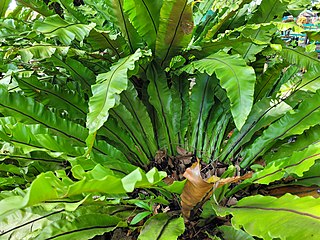
Asplenium nidus is an epiphytic species of fern in the family Aspleniaceae, native to tropical southeastern Asia, eastern Australia, Hawaii, Polynesia, Christmas Island, India, and eastern Africa. It is known by the common names bird's-nest fern or simply nest fern.
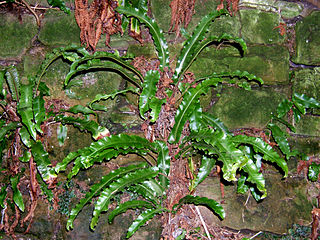
Asplenium scolopendrium, commonly known as the hart's-tongue fern, is an evergreen fern in the family Aspleniaceae native to the Northern Hemisphere.

Megalagrion is a genus of damselflies in the family Coenagrionidae. It contains approximately 26 species, all of which are endemic to Hawaiʻi. Megalagrion damselflies are the only native damselflies in Hawaiʻi, and are referred to as "pinapinao" in ʻ ʻŌlelo Hawaiʻi. Other endemic Hawaiian Odonata are the dragonflies Anax strenuus and Nesogonia blackburni, which are referred to as "pinao".

Amastra spirizona is a species of land snail, a terrestrial pulmonate gastropod mollusk in the Amastridae family.
Asplenium ascensionis is a species of fern in the family Aspleniaceae that is endemic to Ascension Island. Its natural habitats are receding due to introduced vegetation. It is threatened by habitat loss.

Lygodium microphyllum is a climbing fern originating in tropical Africa, Southeast Asia, Melanesia and Australia. It is an invasive weed in Florida where it invades open forest and wetland areas. The type specimen was collected in the vicinity of Nabúa, on the island of Luzon in the Philippines by Luis Née.

Asplenium ceterach, also known as the rustyback fern, is a fern species in the spleenwort family Aspleniaceae.

Asplenium trichomanes, the maidenhair spleenwort, is a small fern in the spleenwort genus Asplenium. It is a widespread and common species, occurring almost worldwide in a variety of rocky habitats. It is a variable fern with several subspecies.

The World's 25 Most Endangered Primates is a list of highly endangered primate species selected and published by the International Union for Conservation of Nature (IUCN) Species Survival Commission (SSC) Primate Specialist Group (PSG), the International Primatological Society (IPS), Global Wildlife Conservation (GWC), and Bristol Zoological Society (BZS). The IUCN/SSC PSG worked with Conservation International (CI) to start the list in 2000, but in 2002, during the 19th Congress of the International Primatological Society, primatologists reviewed and debated the list, resulting in the 2002–2004 revision and the endorsement of the IPS. The publication was a joint project between the three conservation organizations until the 2012–2014 list when BZS was added as a publisher. The 2018–2020 list was the first time Conservation International was not among the publishers, replaced instead by GWC. The list has been revised every two years following the biannual Congress of the IPS. Starting with the 2004–2006 report, the title changed to "Primates in Peril: The World's 25 Most Endangered Primates". That same year, the list began to provide information about each species, including their conservation status and the threats they face in the wild. The species text is written in collaboration with experts from the field, with 60 people contributing to the 2006–2008 report and 85 people contributing to the 2008–2010 report. The 2004–2006 and 2006–2008 reports were published in the IUCN/SSC PSG journal Primate Conservation,, since then they have been published as independent publications.
Asplenium hermannii-christii, Hermann Christ's asplenium, is a species of spleenwort that is endemic to Georgia. It is known from only one location, in the Bzyb River gorge in Abkhazia. It can be found on calcareous rock crevices in the lower montane zone, from elevations of 150–170 m. It is threatened by recreational activities. This species is named after fern botanist Konrad H. Christ.
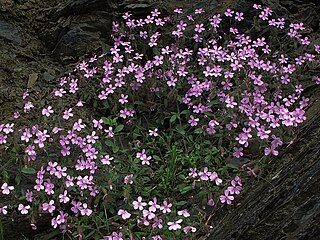
Petrocoptis pseudoviscosa, commonly known as falguera, is a species of plant in the family Caryophyllaceae. It is endemic to the Spanish province of Huesca, where it is only known from the Valle del Ésera in the Pyrenees. Its natural habitat is calcareous cliffs, crags and caves.
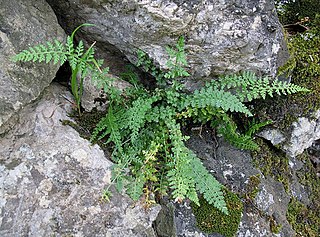
Asplenium fontanum, commonly known as fountain spleenwort or smooth rock spleenwort, is a species of fern in the family Aspleniaceae, native to rocky areas in Western Europe.
Asplenium haughtonii, also known as the Barn fern, is a species of fern in the family Aspleniaceae. It is native to Saint Helena.
Asplenium complanatum is a species of fern in the family Aspleniaceae. It is native to Seychelles. It is listed as critically endangered by the IUCN.
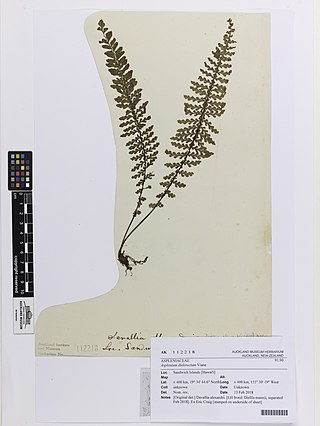
Asplenium dielerectum is a fern, a member of the spleenwort family. It is critically endangered.

Patrick John Brownsey was a British-born New Zealand botanist who specialised in the systematics of New Zealand ferns, and was for 44 years curator of botany at the National Museum of New Zealand and Te Papa.
Asplenium unisorum, the singlesorus island spleenwort, is a species of fern endemic to the Hawaiian Islands.

Asplenium aethiopicum is a lithophytic or sometimes epiphytic species of fern found in Southern and tropical Africa, tropical America, Asia and Australia. It is listed as critically endangered in Victoria, Australia. It is considered exotic in New Zealand.

Woodsia glabella, commonly known as the smooth cliff fern, is a species of homosporous fern. An obligate lithophyte, it is found in the Holarctic realm. It can be found at altitudes of up to 1500–3000 m. The species name glabella is a diminutive of the Latin word glaber, meaning without hair, and refers to the plant's glabrousness.















